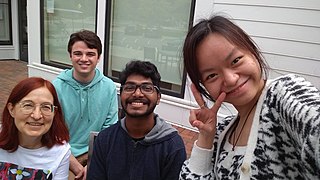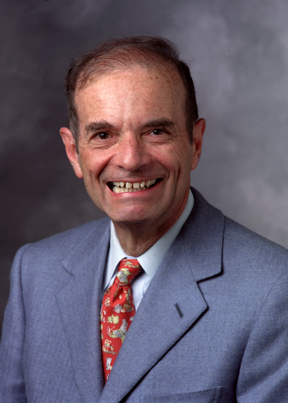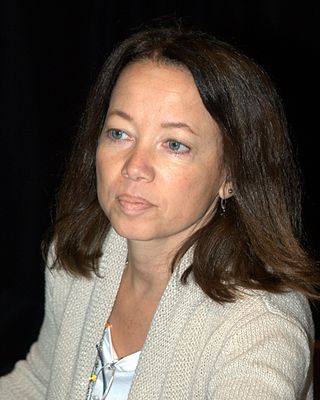Neil Allison Campbell was an American scientist known best for his textbook, Biology, first published in 1987 and repeatedly through many subsequent editions. The title is popular worldwide and has been used by over 700,000 students in both high school and college-level classes.

Joan Lyn Slonczewski is an American microbiologist at Kenyon College and a science fiction writer who explores biology and space travel. Her books have twice earned the John W. Campbell Memorial Award for Best Science Fiction Novel: A Door into Ocean (1987) and The Highest Frontier (2011). With John W. Foster and Erik Zinser, she coauthors the textbook, Microbiology: An Evolving Science now in its fifth edition.

Lubert Stryer is the Emeritus Mrs. George A. Winzer Professor of Cell Biology, at Stanford University School of Medicine. His research over more than four decades has been centered on the interplay of light and life. In 2007 he received the National Medal of Science from President Bush at a ceremony at the White House for elucidating the biochemical basis of signal amplification in vision, pioneering the development of high density microarrays for genetic analysis, and authoring the standard undergraduate biochemistry textbook, Biochemistry. It is now in its tenth edition and also edited by Jeremy Berg, Justin Hines, John L. Tymoczko and Gregory J. Gatto, Jr.

Robin Elizabeth Wells is an American economist. She is the co-author of several economics texts, mostly with her husband Paul Krugman.

Jennifer Anne Doudna is an American biochemist who has done pioneering work in CRISPR gene editing, and made other fundamental contributions in biochemistry and genetics. Doudna was one of the first women to share a Nobel in the sciences. She received the 2020 Nobel Prize in Chemistry, with Emmanuelle Charpentier, "for the development of a method for genome editing." She is the Li Ka Shing Chancellor's Chair Professor in the department of chemistry and the department of molecular and cell biology at the University of California, Berkeley. She has been an investigator with the Howard Hughes Medical Institute since 1997.

Catherine Rosemary Martin is a Professor of Plant Sciences at the University of East Anglia (UEA) and project leader at the John Innes Centre, Norwich, co-ordinating research into the relationship between diet and health and how crops can be fortified to improve diets and address escalating chronic disease globally.

Lucy Shapiro is an American developmental biologist. She is a professor of Developmental Biology at the Stanford University School of Medicine. She is the Virginia and D.K. Ludwig Professor of Cancer Research and the director of the Beckman Center for Molecular and Genetic Medicine.

Christine Anne Orengo is a Professor of Bioinformatics at University College London (UCL) known for her work on protein structure, particularly the CATH database. Orengo serves as president of the International Society for Computational Biology (ISCB), the first woman to do so in the history of the society.

Elaine Ann Ostrander is an American geneticist at the National Human Genome Research Institute (NHGRI) of the National Institutes of Health (NIH) in Bethesda, Maryland. She holds a number of professional academic appointments, currently serving as Distinguished and Senior Investigator and head of the NHGRI Section of Comparative Genomics; and Chief of the Cancer Genetics and Comparative Genomics Branch. She is known for her research on prostate cancer susceptibility in humans and for conducting genetic investigations with the Canis familiaris —the domestic dog— model, which she has used to study disease susceptibility and frequency and other aspects of natural variation across mammals. In 2007, her laboratory showed that much of the variation in body size of domestic dogs is due to sequence changes in a single gene encoding a growth-promoting protein.
Edith Grace White was an American zoologist known for her studies of elasmobranchs. She was a professor of biology at Wilson College, and was a research associate of the American Museum of Natural History in New York City.
Harold Schultz Slusher is an American physicist and young earth creationist.
Beryl B. Simpson is a professor emerita in the Department of Integrative Biology at the University of Texas at Austin. Previously she was an associate curator at the Smithsonian National Museum of Natural History in the Department of Botany. She studies plant systematics and tropical botany, focusing on angiosperms found in the American Southwest, Mexico, and Central and South America. She was awarded the José Cuatrecasas Medal for Excellence in Tropical Botany for her decades of work on the subject.
Carol A. Gross is a molecular biologist and professor of cell and tissue biology at the University of California San Francisco (UCSF). Her research focuses on transcriptional regulation in bacteria.
Sarah Anne Tishkoff is an American geneticist and the David and Lyn Silfen Professor in the Department of Genetics and Biology at the University of Pennsylvania. She also serves as a director for the American Society of Human Genetics and is an associate editor at PLOS Genetics, G3, and Genome Research. She is also a member of the scientific advisory board at the David and Lucile Packard Foundation.
Valerie Dean O'Loughlin is a Clinical Professor of Anatomy and Cell Biology at the Indiana University School of Medicine, Bloomington, co-author of two anatomy textbooks, now in their 3rd and 5th editions, and a Fellow of the American Association of Anatomists.
Nancy B. Simmons is an American zoologist, mammalogist, professor, and author. Specializing in bats, Simmons has conducted extensive research on the morphology and evolutionary history of numerous bat species. She is also the curator-in-charge of the Department of Mammalogy at the American Museum of Natural History and a professor at the Richard Gilder Graduate School.
Laurie Jeanne Butler is an American physical chemist known for her experimental work testing the Born–Oppenheimer approximation on separability of nuclear and electron motions. She is a Fellow of the American Physical Society and a professor emeritus of chemistry at the University of Chicago.

Abigail A. Salyers was a microbiologist who pioneered the field of human microbiome research. Her work on the bacterial phylum Bacteroidetes and its ecology led to a better understanding of antibiotic resistance and mobile genetic elements. At a time where the prevailing paradigm was focused on E. coli as a model organism, Salyers emphasized the importance of investigating the breadth of microbial diversity. She was one of the first to conceptualize the human body as a microbial ecosystem. Over the course of her 40-year career, she was presented with numerous awards for teaching and research and an honorary degree from ETH Zurich, and served as president of the American Society for Microbiology.
N. Louise Glass is the Fred E. Dickinson Chair of Wood Science and Technology at the University of California, Berkeley. She specialises in plant and microbial biology, particularly fungal cell biology and genetics
Catherine Alison Geissler, Lady Auld is a prominent British nutritionist and author and co-author of widely recognised reference textbooks on human nutrition.








